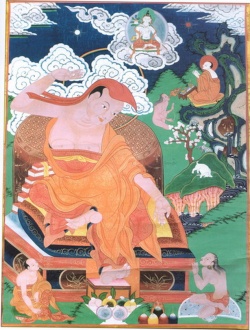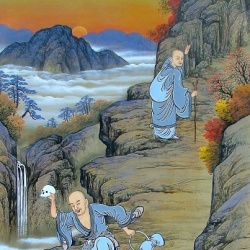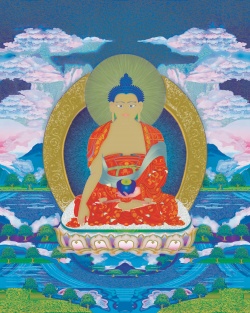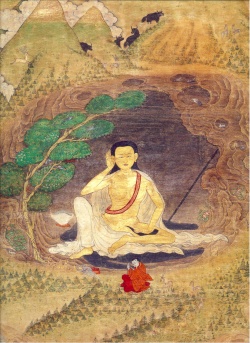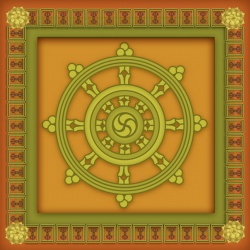Discovering Magic
Any perception can connect us to reality properly and fully. What we see doesn’t have to be pretty, particularly; we can appreciate anything that exists. There is some principle of magic in everything, some living quality. Something living, something real, is taking place in everything.
In twentieth-century society, the appreciation of simplicity has almost been lost. From London to Tokyo, there are problems with trying to create pleasure and comfort out of speed. The world is mechanized to such an extent that you don’t even have to think. You just push a button and a computer gives you the answer. You don’t have to learn to count. You press a button, and a machine counts for you. Casualness has become increasingly popular, because people think in terms of efficiency rather than appreciation. Why bother to wear a tie, if the purpose of wearing clothes is just to cover your body? If the reason for eating food is only to fill your stomach and provide nutrition, why bother to look for the best meat, the best butter, the best vegetables?
But the reality of the world is something more than the lifestyle that the twentieth-century world has embraced. Pleasure has been cheapened, joy has been reduced, happiness has been computerized. The goal of warriorship is to reconnect to the nowness of reality, so that you can go forward without destroying simplicity, without destroying your connection to this earth. In the last chapter, we discussed the importance of nowness as a way of joining together the wisdom of the past with the challenge of the present. In this chapter, we are going to discuss how to discover the ground of nowness. In order to rediscover nowness, you have to look back, back to where you came from, back to the original state. In this case, looking back is not looking back in time, going back several thousand years. It is looking back into your own mind, to before history began, before thinking began, before thought ever occurred. When you are in contact with this original ground, then you are never confused by the illusions of past and future. You are able to rest continuously in nowness.
This original state of being can be likened to a primordial, or cosmic, mirror. By primordial we mean unconditioned, not caused by any circumstances. Something primordial is not a reaction for or against any situation. All conditionality comes from unconditionality. Anything that is made has to come from what was unmade, to begin with. If something is conditioned, it has been created or formed. In the English language, we speak of formulating ideas or plans, or we may say, “How should we form our organization?” or we may talk about the formation of a cloud.
In contrast to that, the unconditioned is free from being formed, free from creation. This unconditioned state is likened to a primordial mirror because, like a mirror, it is willing to reflect anything, from the gross level up to the refined level, and it still remains as it is. The basic frame of reference of the cosmic mirror is quite vast, and it is free from any bias: kill or cure, hope or fear.
The way to look back and experience the state of being of the cosmic mirror is simply to relax. In this case relaxation is quite different from the setting-sun idea of flopping or taking time off, entertaining yourself with a good vacation. Relaxation here refers to relaxing the mind, letting go of the anxiety and concepts and depression that normally bind you. The way to relax, or rest the mind in nowness, is through the practice of meditation. In Part One, we discussed how the practice of meditation is connected to renouncing small-mindedness and personal territory. In meditation you are neither “for” nor “against” your experience. That is, you don’t praise some thoughts and condemn others, but you take an unbiased approach. You let things be as they are, without judgment, and in that way you yourself learn to be, to express your existence directly, nonconceptually. That is the ideal state of relaxation, which allows you to experience the nowness of the cosmic mirror. In fact, it is already the experience of the cosmic mirror.
If you are able to relax—relax to a cloud by looking at it, relax to a drop of rain and experience its genuineness—you can see the unconditionality of reality, which remains very simply in things as they are, very simply. When you are able to look at things without saying, “This is for me or against me,” “I can go along with this,” or “I cannot go along with this,” then you are experiencing the state of being of the cosmic mirror, the wisdom of the cosmic mirror. You may see a fly buzzing; you may see a snowflake; you may see ripples of waters; you may see a black widow spider. You may see anything, but you can actually look at all of those things with simple and ordinary, but appreciative, perception.
You experience a vast realm of perceptions unfolding. There is unlimited sound, unlimited sight, unlimited taste, unlimited feeling and so on. The realm of perception is limitless, so limitless that perception itself is primordial, unthinkable, beyond thought. There are so many perceptions that they are beyond imagination. There are a vast number of sounds. There are sounds that you have never heard. There are sights and colors that you have never seen. There are feelings that you have never experienced before. There are endless fields of perception.
Perception here is not just what you perceive but the whole act of perceiving—the interaction between consciousness, the sense organs, and the sense fields, or the objects of perception. In some religious traditions, sense perceptions are regarded as problematic, because they arouse worldly desires. However, in the Shambhala tradition, which is a secular tradition rather than a religious one, sense perceptions are regarded as sacred. They are regarded as basically good. They are a natural gift, a natural ability that human beings have. They are a source of wisdom. If you don’t see sights, if you don’t hear sounds, if you don’t taste food, you have no way to communicate with the phenomenal world at all. But because of the extraordinary vastness of perception, you have possibilities of communicating with the depth of the world—the world of sight, the world of sound—the greater world.
In other words, your sense faculties give you access to possibilities of deeper perception. Beyond ordinary perception, there is super-sound, super-smell, and super-feeling existing in your state of being. These can be experienced only by training yourself in the depth of meditation practice, which clarifies any confusion or cloudiness and brings out the precision, sharpness, and wisdom of perception—the nowness of your world. In meditation, you experience the precision of breath going in and out. You feel your breath: It is so good. You breathe out, breath dissolves: It is so sharp and good, it is so extraordinary that ordinary preoccupations become superfluous. So meditation practice brings out the supernatural, if I may use that word. You do not see ghosts or become telepathic, but your perceptions become supernatural, simply super-natural.
Normally, we limit the meaning of perceptions. Food reminds us of eating; dirt reminds us to clean the house; snow reminds us that we have to clean off the car to get to work; a face reminds us of our love or hate. In other words, we fit what we see into a comfortable or familiar scheme. We shut any vastness or possibilities of deeper perception out of our hearts by fixating on our own interpretation of phenomena. But it is possible to go beyond personal interpretation, to let vastness into our hearts through the medium of perception. We always have a choice: We can limit our perception so that we close off vastness, or we can allow vastness to touch us.
When we draw down the power and depth of vastness into a single perception, then we are discovering and invoking magic. By magic we do not mean unnatural power over the phenomenal world, but rather the discovery of innate or primordial wisdom in the world as it is. The wisdom we are discovering is wisdom without beginning, something naturally wise, the wisdom of the Cosmic mirror. In Tibetan, this magical quality of existence, or natural wisdom, is called drala. Dra means “enemy” or “opponent” and la means “above.” So drala literally means “above the enemy,” “beyond the enemy.” Drala is the unconditioned wisdom and power of the world that are beyond any dualism; therefore drala is above any enemy or conflict. It is wisdom beyond aggression. It is the self-existing wisdom and power of the Cosmic mirror that are reflected both in us and in our world of perception.
One of the key points in discovering drala principle is realizing that your own wisdom as a human being is not separate from the power of things as they are. They are both reflections of the unconditioned wisdom of the cosmic mirror. Therefore there is no fundamental separation or duality between you and your world. When you can experience those two things together, as one, so to speak, then you have access to tremendous vision and power in the world–you find that they are inherently connected to your own vision, your own being. That is discovering magic. We are not talking here about an intellectual revelation; we are speaking of actual experience. We are talking about how we actually perceive reality. The discovery of drala may come as an extraordinary smell, a fantastic sound, a vivid color, an unnatural taste. Any perception can connect us to reality properly and fully. What we see doesn’t have to be pretty, particularly; we can appreciate anything that exists. There is some principle of magic in everything, some living quality. Something living, something real is taking place in everything.
When we see things as they are, they make sense to us: the way leaves move when they are blown by the wind, the way rocks get wet when there are snowflakes sitting on them. We see how things display their harmony and their chaos at the same time. So we are never limited by beauty alone, but we appreciate all sides of reality properly.
Many stories and poems written for children describe the experience of invoking the magic of a simple perception. One example is “Waiting at the Window” from Now We Are Six, by A. A. Milne. It is a poem about spending several hours on a rainy day looking out the window, watching drops of water come down and make patterns on the glass. Reading this poem, you see the window, the rainy day, and the child with his face pressed to the glass watching the raindrops, and you feel the child’s sense of delight and wonder. The poems of Robert Louis Stevenson in A Child’s Garden of Verses have a similar quality of using very ordinary experiences to communicate the depth of perception. The poems “My Shadow,” “My Kingdom,” and “Armies in the Fire” exemplify this. The fundamental vastness of the world cannot be expressed directly in words, but in children’s literature, very often it is possible to express that vastness in simplicity.
The Little Prince by Antoine de Saint-Exupéry is another wonderful example of literature that evokes the sense of ordinary, or elemental, magic. At one point in this story, the little prince meets a fox. The prince is very lonely and wants the fox to play with him, but the fox says that he cannot play unless he is tamed. The little prince asks the meaning of the word “tame.” The fox explains that it means “to establish ties” in such a way that the fox will become unique to the little prince, and the prince unique to the fox. Later, after the fox has been tamed and the little prince must leave him, the fox also tells the prince what he calls “my secret, a very simple secret,” which is, “it is only with the heart that one can see rightly; what is essential is invisible to the eye.”
Saint-Exupéry has a different vocabulary here for describing the discovery of magic, or drala, but the experience is basically the same. Discovering drala is indeed to establish ties to your world, so that each perception becomes unique. It is to see with the heart, so that what is invisible to the eye becomes visible as the living magic of reality. There may be thousands or billions of perceptions, but they are still one. If you see one candle, you know exactly what all the candles in the whole world look like. They are all made out of fire, flame. Seeing one drop of water can be seeing all water.
Drala could almost be called an entity. It is not quite on the level of a god or gods, but it is an individual strength that does exist. Therefore, we not only speak of drala principle, but we speak of meeting the “dralas.” The dralas are the elements of reality—water of water, fire of fire, earth of earth—anything that connects you with the elemental quality of reality, anything that reminds you of the depth of perception. There are dralas in the rocks or the trees or the mountains or a snowflake or a clod of dirt. Whatever is there, whatever you come across in your life, those are the dralas of reality. When you make that connection with the elemental quality of the world, you are meeting dralas on the spot; at that point, you are meeting them. That is the basic existence of which all human beings are capable. We always have possibilities of discovering magic. Whether it is medieval times or the twentieth century, the possibility of magic is always there.
A particular example of meeting drala, in my personal experience, is flower arranging. Whatever branches you find, none of them is rejected as ugly. They can always be included. You have to learn to see their place in the situation; that is the key point. So you never reject anything. That is how to make a connection with the dralas of reality.
Drala energy is like the sun. If you look in the sky, the sun is there. By looking at it, you don’t produce a new sun. You may feel that you created or made today’s sun by looking at it, but the sun is eternally there. When you discover the sun in the sky, you begin to communicate with it. Your eyes begin to relate with the light of the sun. In the same way, drala principle is always there. Whether you care to communicate with it or not, the magical strength and wisdom of reality are always there. That wisdom abides in the cosmic mirror. By relaxing the mind, you can reconnect with that primordial, original ground, which is completely pure and simple. Out of that, through the medium of your perceptions, you can discover magic, or drala. You actually can connect your own intrinsic wisdom with a sense of greater wisdom or vision beyond you.
You might think that something extraordinary will happen to you when you discover magic. Something extra-ordinary does happen. You simply find yourself in the realm of utter reality, complete and thorough reality.
